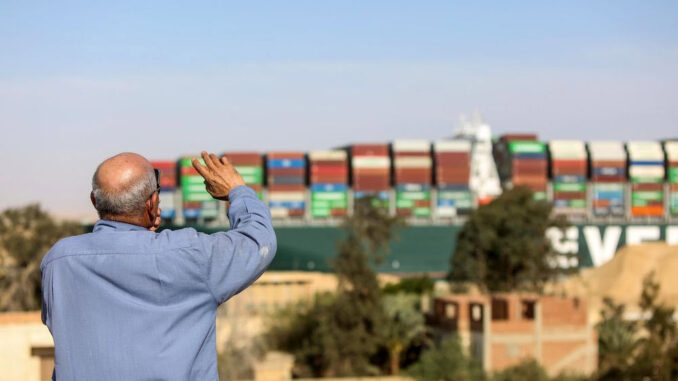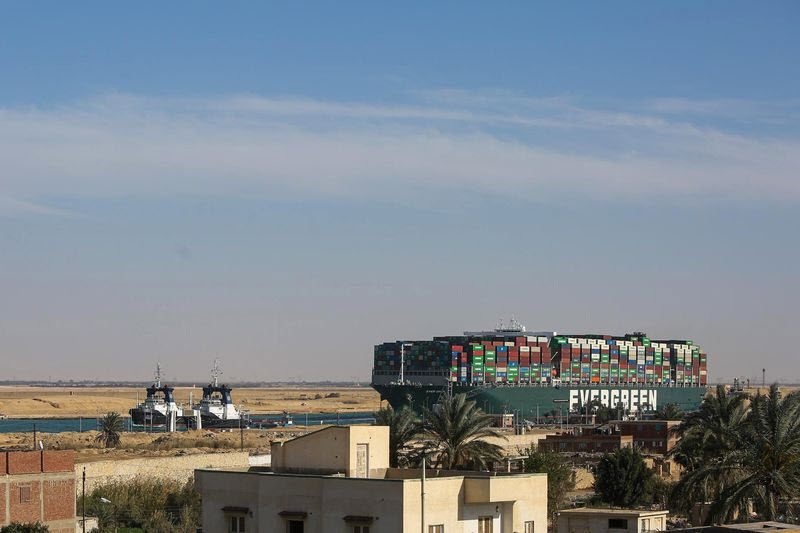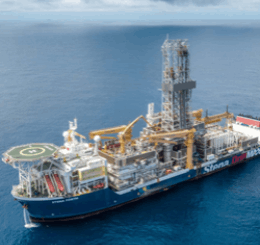
In the end, it took roughly six days and seven hours to undo the minutes of drama that exposed the vulnerability of global trade and captivated the world. It may take longer to figure out how to avoid it happening again.
At just after 3 p.m. local time on Monday, the Ever Given was dislodged from a sand bank in the Suez Canal by tugboats pushing and pulling to rock it loose. To cheers from the dozens of crew working on the effort to refloat it and relief among Egyptian authorities, the enormous 21st century container ship that got stuck in a waterway first opened in 1869 was free. The backlog of about 400 ships started moving that evening.

“Despite the difficult situation we’ve confronted, Egyptians stood beside their leadership and their country and endured the crises and registered their joy,” President Abdel Fattah El-Sisi declared at a press conference on Tuesday alongside Osama Rabie, the chief executive of the Suez Canal Authority.
Yet, the fallout from the incident in such a vital artery of the globalized economy is just beginning. Insurers are already totting up the cost and who might be on the hook, but the real focus is quickly shifting to what went wrong.
There will be questions about speed, whether the Ever Given should have employed tugs and if it should have braved the journey through the wind at all. Egyptian investigators, led by a canal authority committee, will analyze recordings from the deck, including conversations among crew.
Read More: When a Desert Wind Blew $10 Billion of Global Trade Off Course
Gusts exceeded 40 miles per hour when Ever Given braved the journey on March 23. The Suez Canal has witnessed plenty of winds and bad weather, and tankers have faced worse without getting stuck, Rabie said.
He distanced Egypt from responsibility, blaming the wind and possible “human and technical errors,” though promised a full probe into what happened. He also said the authority will look into whether they need new tugs with better capabilities.
“The Suez Canal authority should learn something on how this accident could have happened and what kind of measures are needed to prevent this,” Peter Berdowski, chief executive of Boskalis, the owner of Netherlands-based salvage experts SMIT, told Dutch radio.
The manager of the ship, Bernhard Schulte Shipmanagement, has already said initial inquiries suggest the accident was due to the wind. An extensive probe is ongoing and will include interviews with pilots onboard and all bridge personnel and other crew, a company spokesman said on March 27.
What’s sure is that the 400-meter-long Ever Given was firmly wedged in the canal’s bank. It was time to call SMIT. As television footage showed tugs were unable to budge the ship, SMIT began scrambling a plan, according to people familiar with the situation.
After being employed by Ever Given’s Japanese owner, Shoei Kisen Kaisha Ltd., on March 24, plane tickets were booked to fly staff to Egypt from the Netherlands. There were media reports that the ship had refloated, but the SMIT team had data on where the vessel was sitting and knew it would require more, the people said.

The problem was the location of the Egyptian tugs. The Suez Canal authorities had deployed tugs to the north side of the Ever Given, and were tugging from there. Because of the way she was lodged into the canal wall, pulling or pushing from that direction was ineffective.
The pressure was on to clear one of the world’s busiest waterways, with all the media and world watching. There was also a tidal deadline. Had the operation missed the highest tide in weeks, it could have meant having to spend days offloading containers.
President El-Sisi said he told Suez chief Rabie to prepare for the worst. “I asked him what is the most difficult scenario,” El-Sisi said on Tuesday. “He told me it’s the offloading of containers. I said let’s be ready. Whatever it costs we have to be ready in a crisis like this.”
By March 26, people familiar with the rescue efforts were expecting it would take until at least this Wednesday to dislodge the vessel. The canal authority had been dredging using a cutter suction dredger called the Mashhour. It basically churns mud and sand underwater, sucks it up and spits it out via a pipeline.
There had been some more refloating attempts, and every time the ship didn’t move, it was a concern for the salvage crew. But a breakthrough came early Monday morning, when the ship was partially dislodged and she started to pivot. The dredgers continued scraping away sand at the bow.
Then it happened. Boskalis CEO Berdowski could see live on the radar the ship was coming afloat. What followed was a “tense 10 minutes,” he told Dutch radio on Monday. “You need to bring it under control quickly with the tugboats before it gets stuck on the other side,” he said. “We would have gone from bad to worse.”

For the Egyptian crew, the relief was even more palpable. President El-Sisi said the country’s reputation was on the line and had been calling regularly during each day for updates, as had other top officials. He said he told Rabie “Egypt is on your neck.”
“The focus now will be on the investigation front, and that’s a big open question,” said Ian Ralby, chief executive of I.R. Consilium, a maritime law and security consulting firm that works with governments. “We need to be looking at the full spectrum of possibilities for this case.”
— With assistance by Fred Pals, Tarek El-Tablawy, and K Oanh Ha – Bloomberg



